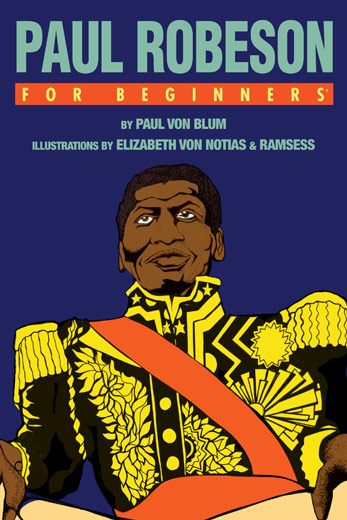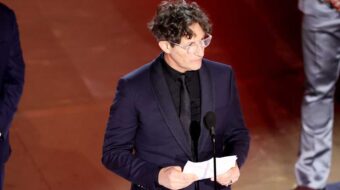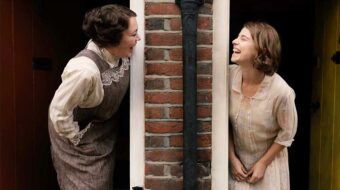
Paul Von Blum, a senior lecturer in African and Communication studies at UCLA, has written a wonderful book that reveals and celebrates the life of an exceptional man who left a majestic and lasting legacy to the world. Unlike other beginner books, Von Blum’s is heavier on printed text than illustrations – gorgeously drawn by artists Elizabeth Von Notias & Ramsess – so the reader gets more information on Robeson’s life. Von Blum’s slim new book should be on every history buff’s reading list.
The post World War II anti-communist witch hunts in the U.S. led to important cultural and political figures being excluded from mainstream history. One of those towering figures was Paul Robeson, America’s first black movie star and pro- football player. Paul Von Blum’s “Paul Robeson for Beginners” is an absorbing biography of this remarkable man who is largely unknown to most Americans.
Born in 1898 to a father who was an escaped slave from North Carolina, Robeson showed early promise. Despite facing barriers based on his skin color, he excelled as a student and athlete, winning a scholarship to study in a largely white university when he was 18. At the same time he started playing pro-football with white teams in the 20s as well as semi-pro basketball and baseball. After transferring to a university near Harlem to study law, he became the first black man to play pro-football and semi pro-basketball to pay his way through school. His athletic contributions were later recognized in 1995 when he was finally inducted into the College Football Hall of Fame, after repeated campaigns by Robeson supporters.
When racism hindered his career in law, after his boss told him that white clients would not want to be represented by a black lawyer, he launched a new career – with the encouragement of his wife – as a an actor and singer. Robeson had dabbled in acting and singing earlier in his life. During the 1920s, Robeson took the country by storm on the stage, winning wide claim in an industry dominated by whites. He also spent substantial time in England, where he felt more at home because there was less racism, performing in plays and giving concerts, winning further recognition and fame. Robeson would keep on returning to the UK to act and sing until his retirement. While he mostly made his mark in the theater, from 1924 to 1942 he made 10 feature films in the UK and USA, including several major Hollywood productions.
In the Broadway hit play Othello, where he played the dark skinned moor in this Shakespearean play, Robeson caused a major scandal when he kissed his white counterpart during the Broadway run of the play in 1943, at a time when inter-racial kisses were taboo. Robeson had broken through the racial barrier that barred blacks from playing lead roles, paving the way for future black actors in Hollywood. Robeson became the first black star in American and British cinema and theater, even though he was criticized for playing stereotypical roles in some productions that promoted racist images of blacks.
Robeson’s singing career also took off in the 20s and major record labels soon sold his work. It is still possible to see clips of Robeson on You Tube singing. By the late 1940s, Robeson had become a wealthy man from his music and acting career.
Beginning in the 1930s, Robeson started speaking out against racial prejudice and segregation in the U.S. and the growing storm clouds of fascism. He also came to believe “that capitalism fostered and exacerbated inequality, poverty, racism and economic and social misery for millions of human beings” and that a socialist transformation of society was necessary. Blum attributes Robeson’s move leftward from his association with leftwing members of the British Labour Party and cultural luminaries such as H.G Wells and George Bernard Shaw. In 1938, he travelled to Spain to support the Republican government and meet with the international brigades who where helping to defend the country from fascist forces.
He also began his long association with the Communist Party USA during the 30s. While never a member, he became a supporter and friend of the party that strongly opposed racism and welcomed black members.
Robeson stopped making films for the major Hollywood studios in 1942 because of their demeaning portrayal of black people. During this period he heightened his political involvement around civil rights, participating in picket lines protesting against the poll tax in the south that prevented blacks from voting as well as commercial establishments that discriminated against blacks. In 1943, he led a delegation to meet with the baseball team owners to persuade them to hire black players.
He spearheaded a national campaign against the lynching of black people in the south by racist mobs that had taken the lives of thousands of innocent men and women. In 1946, Robeson led a delegation to Washington to ask President Harry Truman to take measures against lynching. Truman said he could not do so because of strong opposition in the south. An angry Robeson told the U.S. President “if the federal government did not defend blacks, blacks would have to defend themselves.” He submitted a petition to the UN in 1951 charging the US with genocide because of the US government’s failure to take action against lynching and institutional racism.
The FBI began an active campaign to undermine Robeson after WWII. Like other left wing actors and singers during this period, Robeson was blacklisted and his acting and singing career withered. The U.S. government even took away his passport in 1948 so he could not travel abroad to act or give concerts for the next 10 years. The FBI also harassed his friends and family members.
The U.S. government’s campaign of harassment did not put a brake on Robeson’s political activism. When 12 CPUSA leaders were arrested on false charges of conspiring to overthrow the US government and brought to trial in 1949, Robeson appeared at the Foley Square courthouse in New York to greet the defendants and show his solidarity. Likewise, he took on the House Committee of Un-American Activities in 1956, using his actors training to good effect. The transcript of the exchange is one of the more interesting tidbits of information that Blum provides. The only thing that seemed to slow Robeson down were bouts of depression that became more severe as time passed on.
After the Supreme Court ordered the government to return his passport in 1958, Robeson was able to go abroad and revive his acting and singing career for a few years longer. Recurring depression finally forced his retirement in the early 1960s. Robeson lived a quiet life with his sister in Philadelphia – where he made few public appearances – until he passed away in 1976.
By Paul Von Blum, illustrations by Elizabeth Von Notias & Ramsess
For Beginners Books, 133 pages, $16.99












Comments